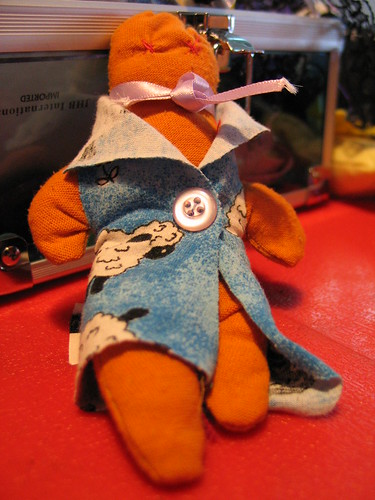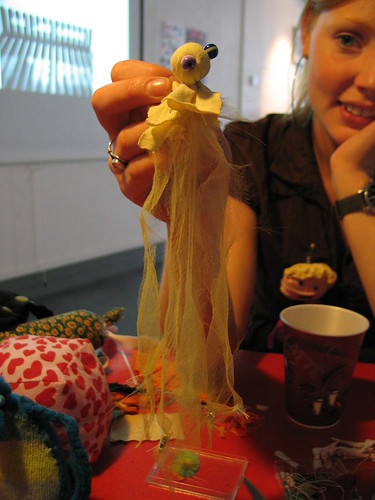I thought that you might be interested in this article Anastasia
June 9, 2007
by
Jennifer 
Our story “Greenwash Your Floors with the Swiffer” launched an interesting debate on our site about greenwashing and eco design . A commenter named Kim called on us to move beyond criticism and contact the designers directly:
If we can educate the product producers about holistic sustainable design systems and principles and give them better solutions, we can effect much more change on a larger scale than we could by simply calling them out on their greenwashing.
So we decided to contact the designer of the Swiffer, Gianfranco Zaccai of Continuum, directly to ask him to explain the Swiffer as an example of sustainability. The interview that came out of this was extremely interesting. Read on for the full debate >
Jennifer Van Der Meer interviews Gianfranco Zaccai about his swiffer design and sustainability
Jennifer: In your argument about the Swiffer’s environmental impact, you cite the fact that your design uses less water, energy, and toxins than a conventional mop. How did you analyze these impacts?
Gianfranco: The development of the Swiffer was the result of our analysis of what average American households actually do to clean their floors. We discovered—by doing a lot of research and observation in people’s homes—that, on the average, kitchen floors are washed once a week and that it requires a lot of hot water and detergent for washing and then more hot water for rinsing. We further realized—just by watching a lot of people mop their floors—that people spend more time cleaning the mop than cleaning the floor.
We also discovered that most of the so-called dirt on the floor is not sticky, adhering dirt, it’s dust. And water turns out to be a particularly bad way to get rid of dust because the dust will just float to the surface and then settle down in the form of mud. Again, we found that out by observing and analyzing—in excruciating detail and many times over—exactly what happens when someone mops the kitchen floor. We also learned that almost no one enjoys washing the floor and touching a dirty mop. Probably anyone could have told you that, but we verified it and, instead of ignoring it because it was so obvious, we really paid attention to it because it was so universal. This is key to what I’m trying to say: Water and energy and chemicals and all that are essential to analyzing this activity for its environmental impact. But so are frustration and boredom and house-pride and resentment of spouses who never do the mopping. Because those are the keys to designing a solution that is profitably sustainable because it is something people will willingly—even joyfully—do.
We put all of this information together and proposed that a single sheet of paper could entrap dust—since dust was most of the problem—by means of an electrostatic process and by modulating the surfaces of the sheet to increase entrapment. Basically, these two processes replace the water, the chemicals in the detergent, the time and back strain associated with filling buckets, and the energy needed to heat the water. And that became the Swiffer. Of course, the Swiffer has some environmental impact. That single sheet of paper goes into the trash. But compared with the many gallons of hot water and detergent used in the old system, this is obviously a lot better. Of course, we also created the Swiffer WetJet, which uses a spray of cleaning agent to spot-clean caked-on dirt, if and when necessary. But we believe that, even here, the total impact of energy consumption and chemicals in the waste stream is better.
By addressing both the technology and the users’ desires, we helped to create a sustainable solution, one which provided value to both the producer and the consumer while reducing the total impact on the environment. And we’re not kidding ourselves that replacing mops with Swiffers is what’s going to turn global warming around. We worked hard to come up with a profitably sustainable solution rather than a profitable but more harmful solution. If we can do that every time and if most other designers are doing that every time, whether they are designing jumbo jets or SpongeBob toys, that will help turn global warming around.

As a designer, how much impact do you have on the materials used in manufacturing what you have designed? Were you involved in specifying the ingredients of the Swiffer cleaning formula?
Well, in that particular case, we were not involved in specifying the ingredients of the cleaning formula of the Swiffer WetJet. In general, though, it depends on how comprehensive the request for our services is. If we are asked to develop a concept which will then be developed through manufacturing by our client’s engineering staff, we will try to develop and propose ideas that are fundamentally less wasteful and will suggest particular materials and processes. On the other hand, when we are asked to fully develop an idea through engineering, both mechanical and electrical, we try to choose environmentally sustainable materials and manufacturing processes. Although we do not employ chemists on our teams, we have sometimes employed consultants from universities in the area; for example, to develop a chemical formula for a biomedical product which had to be benign with respect to the environment.
How would you define sustainability?
In my view, the concept of sustainability cannot be limited to environmental issues. Finding the “right thing to do” won’t help much if most people won’t do it. We need to find the best thing to do that many people will do—because it’s enjoyable, beneficial, and engaging for them—and that is economically viable. Unfortunately, human beings have a difficult time seeing the relationship between their behavior and its effects if those effects are too distant in time or space. So people may pay lip service to more eco-friendly behavior—public transportation, for example—but unless that behavior provides short-term gratification, it is not likely to be sustainable.
What does this mean for designers?
Our job is to (1) carefully analyze the real environmental impact of some activity—anything from taking a bath to generating power, (2) understand what human values and desires are involved in that activity, and (3) find the elegant solution that provides greater value—that means greater physical, emotional, and social satisfaction as well as greater economic benefit—while avoiding harm to the environment as much as possible.
Do you think the design community is adopting a more sustainable process?
Unfortunately, the design community is very fragmented and, to a great extent, unprepared at this point. Some designers and some design firms are beginning to adopt cradle-to-cradle design practices and to be more conscious of the impact of design decisions dealing with energy consumption and material waste. But the idea of doing better with less is only beginning to take hold.

What have you learned from the experience of being criticized for your sustainability claims?
I am not at all bothered by constructive criticism. It provokes further thought on my part and it gives me the opportunity to communicate with greater detail what we are trying to do in this arena.
Do you think the consumer products industry needs a certification process—similar to LEED standards for buildings—in order to verify the authenticity of green claims and combat claims of greenwashing?
I think these things are inevitable. It will take some time to do it right and to have the general population adopt this mind shift, but, like all important progress, I believe it will eventually come about.
Beyond meeting certain EU regulations (ROHS and WEEE, for example), what kinds of sustainability issues is Continuum investigating for its clients?
Our work is broad in scope, going beyond products to the design of environments and services. We are therefore looking into many different methods for evaluating sustainability and environmentally conscious design—everything from smarter materials and longer-lasting products that serve multiple functions to consumer environments, such as stores and restaurants, that use natural light or buy as much of their food as possible from local farms.
Right now we are working with solar energy, air purification, chemical-free bug and pest detection, shared high-end transportation in urban settings, and medical devices with longer shelf lives and with less plastic, fewer wires, and lower electrical consumption (yet with far less error than previous versions of these products)—to name a few.
In the design process, who is most influential in pushing for “better” solutions: designers, clients, government, or consumers?
All of those constituencies have equal responsibility and, I believe, equal power. Nevertheless, the focus up until now has been on legislation—which is a “push” mindset. The power of the customer and of designers has been discounted. I think designers can create a “pull” effect whereby customers demand more sustainable solutions not only because they are environmentally sound, but because they give better value, provide more enjoyment, and make people feel better about their choices.



































